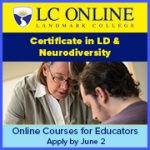504 Plan: The 504 Plan is a plan developed to ensure that a child who has a disability identified under the Rehabilitation Act and is attending an elementary or secondary educational institution receives accommodations that will ensure their academic success and access to the learning environment. These accommodations and modifications must ensure that there is no discrimination because of the child’s disability.
Accommodations: Curricular adaptations that compensate for learners’ weaknesses without modifying the curriculum.
Admission, Review and Dismissal (ARD): The name given to the committee used in some states (in other states not using the term ARD, they are called IEP teams or IEP committees) that is responsible for the development and review of a child’s individualized education plan (IEP), evaluation and re-evaluation, functional behavioral analysis (FBA), and behavior intervention plan (BIP). The ARD committee meets at least once per year to review the IEP and construct a new plan for the coming year. In addition to the annual review meeting, other meetings can be called by teachers or parents whenever needed. This group is responsible for creating, implementing and maintaining the educational program from students with disabilities, as identified by IDEA.
Annual Review (AR): The yearly meeting of the individualized education program (IEP) team (or called ARD committee in some states). The AR is designed to gather all the IEP team members in one location to update one another on a student’s needs and performance by reviewing progress toward goals and looking at new data like work samples and recent testing.
Assessment: Evaluations used to identify a student’s strengths, weaknesses, and progress. These tests are designed to provide an overview of a child’s academic performance, basic cognitive functioning and/or his or her current strengths or weaknesses; they can also test hearing and vision. Assessments can consist of anything from the observations of a teacher or aide to standardized and criterion-referenced tests to complex, multi-stage procedures such as a group of teachers assembling a large portfolio of student work.
Assistive Technology (AT): Assistive technology is technology used by individuals with disabilities in order to perform functions that might otherwise be difficult or impossible. Assistive technology can include mobility devices such as walkers and wheelchairs, as well as hardware, software, and peripherals that assist people with disabilities in accessing computers or other information technologies.
Emotional Disturbance (ED): A mental health issue including, but not limited to, anxiety disorders, bipolar disorder (sometimes called manic-depression), conduct disorders, eating disorders, obsessive-compulsive disorder (OCD) and psychotic disorders.
Free and Appropriate Public Education (FAPE): The education to which every student is entitled under IDEA. Every student is entitled to an education that is appropriate for his or her unique needs, and that is provided free of charge.
Hearing Impairment: An impairment in hearing, whether permanent or fluctuating, that adversely affects a child’s educational performance.
Inclusion, Inclusive Classroom: The term inclusion communicates an all-embracing societal ideology. Regarding individuals with disabilities and special education, inclusion secures opportunities for students with disabilities to learn inside mainstream classrooms. Mainstream classrooms in which students with disabilities learn are known as inclusive classrooms.
Individualized Education Program (IEP): A legal document that defines special education services between the school district and the parents.
IEP Team: The team of qualified professionals made up of the parent, special education teacher, interpreter of test data, district representative, and general education teacher at a minimum. This group makes all decisions related to the instructional program of a child with special needs, including placement and services provided. In some states, this team is called the admission, review, and dismissal (ARD) team.
Individuals with Disabilities Education Act (IDEA): A law that guarantees educational rights to all students with disabilities
Interventions: Sets of teaching procedures used by educators to help students who are struggling with a skill or lesson succeed in the classroom.
Least Restrictive Environment (LRE): The environment in which students with disabilities must be educated, as mandated by The Individuals with Disabilities Act (IDEA). Students with disabilities must be educated in a classroom setting that is as close to the general education setting as possible.
Modifications: Curricular adaptations that compensate for learners’ weaknesses by changing or lowering expectations or standards.
Other Health Impairment (OHI): A disability category under IDEA that lists examples of health-related conditions that may qualify a child for special education: attention-deficit/hyperactivity disorder, diabetes, epilepsy, heart conditions, hemophilia, lead poisoning, leukemia, nephritis, rheumatic fever, sickle cell anemia, and Tourette syndrome.
Response to Intervention (RTI): A process used by educators to help students who are struggling with a skill or lesson. If a child does not respond to the initial interventions, more focused interventions are used to help the child master the skill. RTI strategies address both learning and behavior.
Special Education (SPED): Term used in the Individuals with Disabilities Education Act (IDEA) that is defined as specially designed instruction to increase the student’s chances for success.
Specific Learning Disability (SLD): A disorder in one or more of the basic psychological processes involved in understanding or in using spoken or written language, that may manifest itself in an imperfect ability to listen, think, speak, read, write, spell or to do mathematical calculations. Specific learning disabilities include conditions such as perceptual disabilities, brain injury, minimal brain dysfunction, dyslexia, and developmental aphasia. The term does not include learning problems that are primarily the result of visual, hearing or motor disabilities, of mental retardation, of emotional disturbance or of environmental, cultural or economic disadvantage.
Speech or Language Impairment (SLI): A communication disorder such as stuttering, impaired articulation, a language impairment, or a voice impairment that adversely affects a child’s educational performance.
Transition/Transition Plan: Transition is a general term used to describe a change in a student’s school or program. A transition plan is specific to an IEP: a student who will turn 16 within the life of his or her individualized education program must have a transition goal and plan that outlines how he or she will transition to life beyond high school.
Transition Meeting: A meeting of the individualized education program (IEP) team prior to a student moving into a new program or school.
Triennial Review (Tri): An IEP review meeting that takes place every three years. During this meeting, the IEP team meets to discuss a student’s continuing eligibility for special education services. It is often combined with the IEP annual review (AR).



